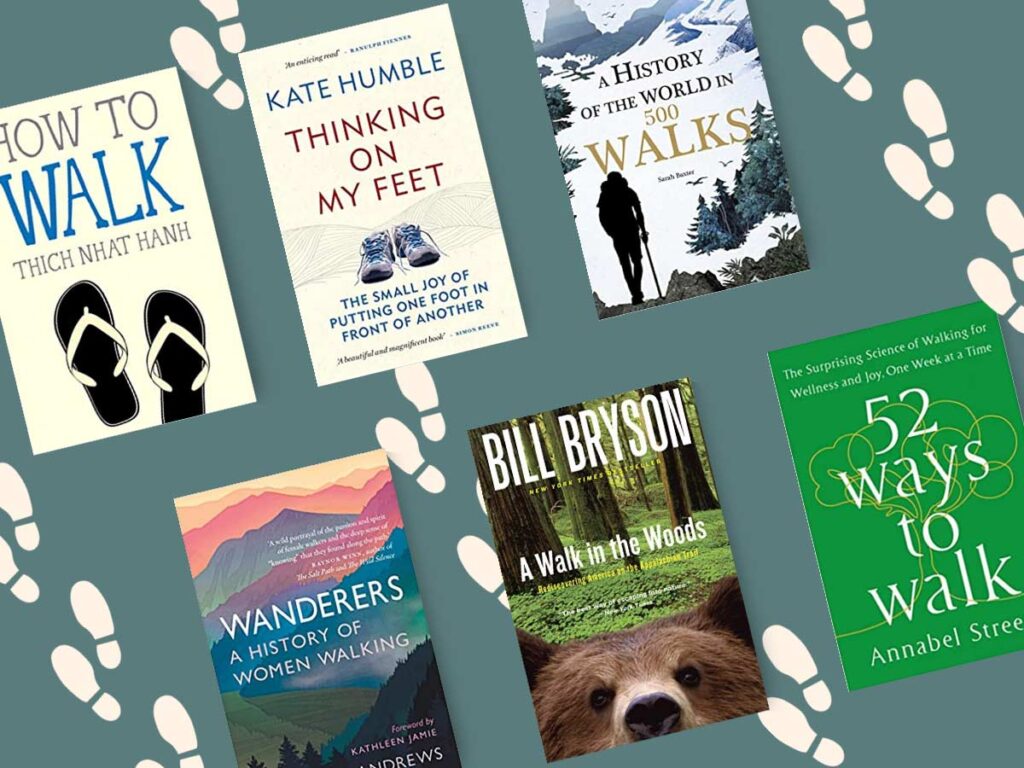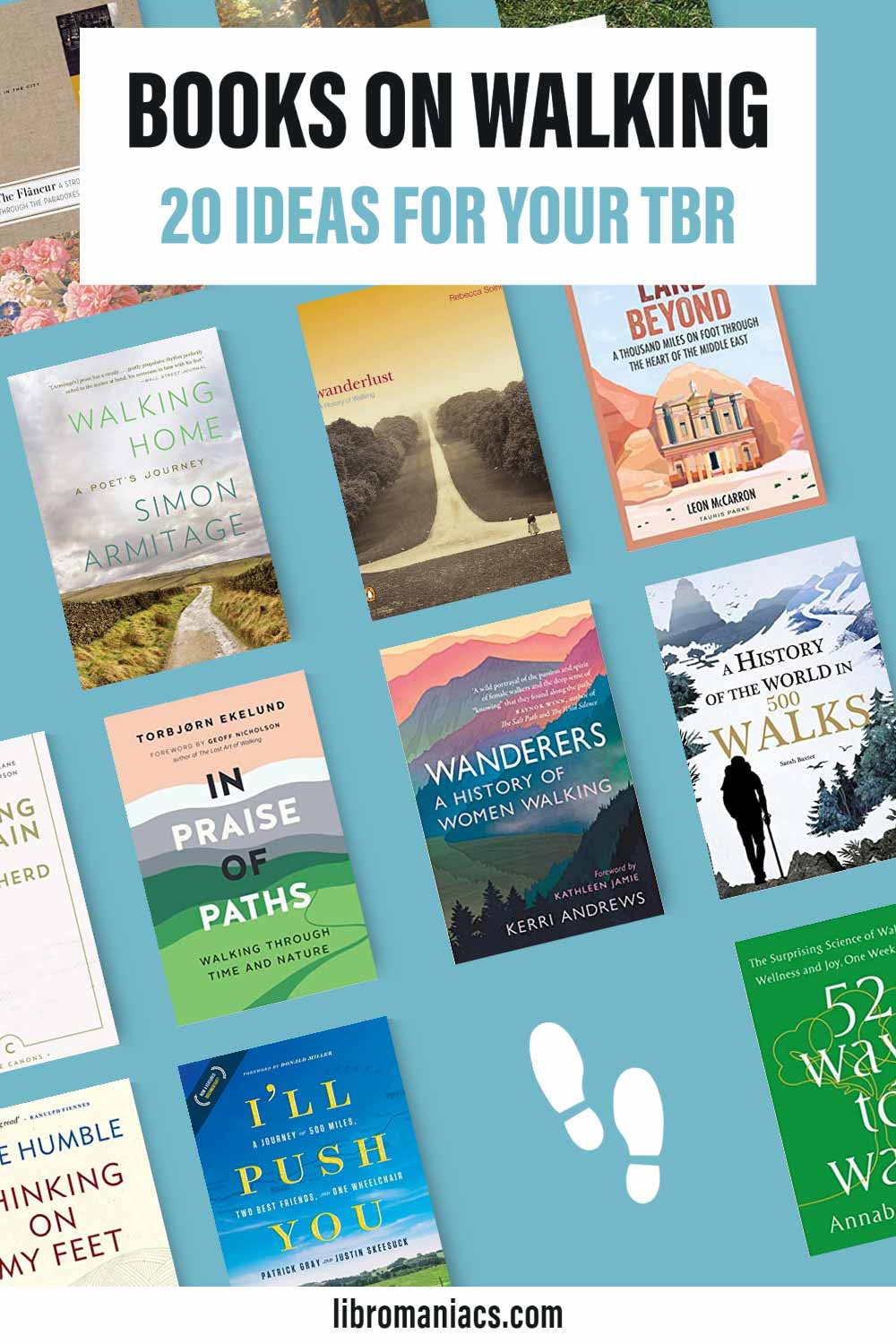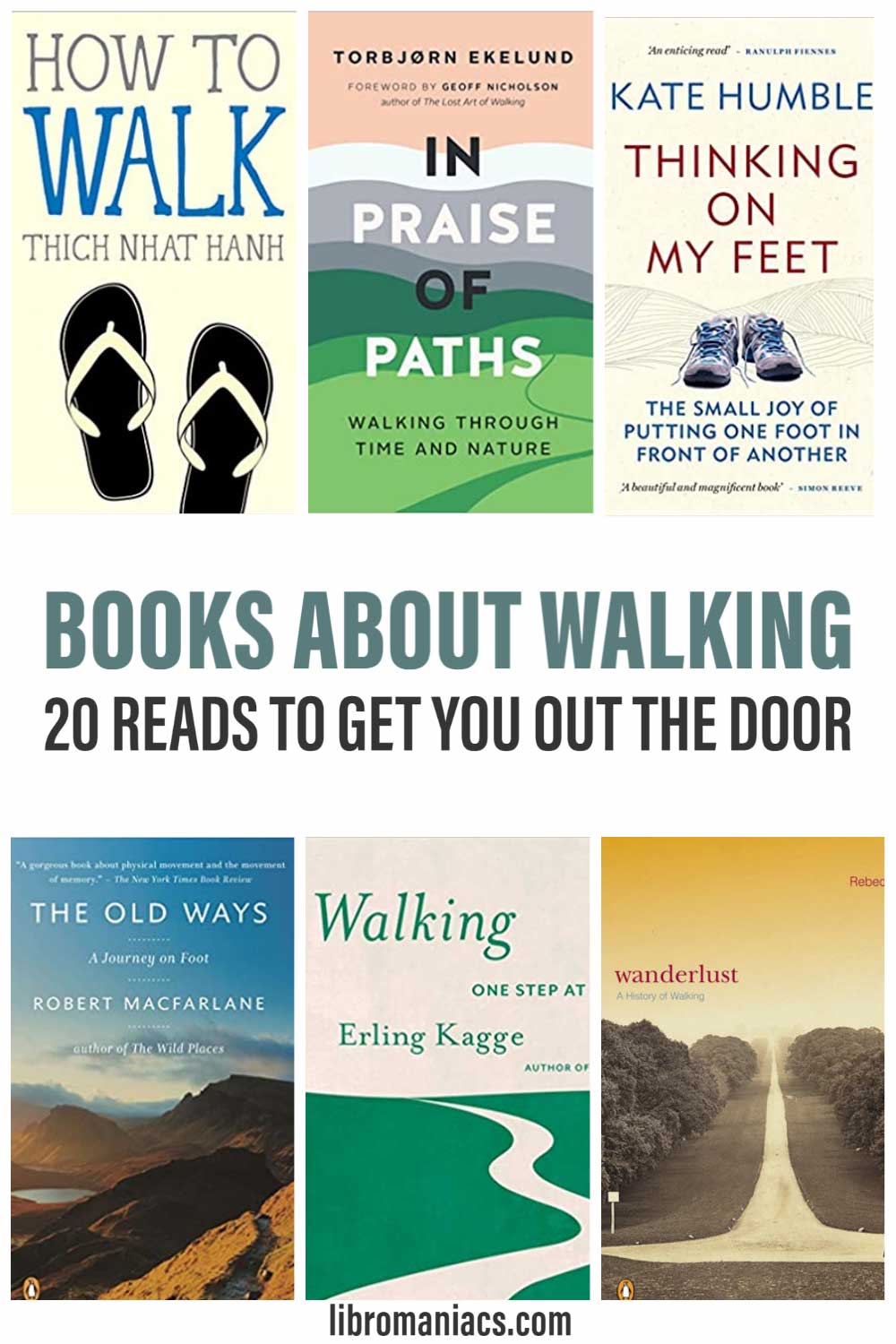Why do we walk? Where and how should we walk? How are people changed by walking? These books about walking explore these questions with thoughtful meditations on the nature of perambulation. I’m an avid walker myself, covering about 800 miles per year, so you’d think I have the topic down pat. And yet, these walking books bring unique insight into the topic. Every time I read another one, I get more food for thought (and fuel for a walk).
So, whether you are also someone who loves a good long walk, or simply seeking motivation to regularize a walking habit, these books will give you inspiration.
The list offers two sections. The first are books that cover the nature of walking: it’s value as a meditative practice, different ways of walking, philosophies and profiles of prolific walkers. The second section feature walking memoirs by people who stared down adversity or explored their inner life through walking.

(This article contains affiliate links. This means that if you choose to purchase, I’ll make a small commission.)
Books on the Nature of Walking

How to Walk (Mindfulness Essentials #4), Thich Nhat Hanh
It seems obvious doesn’t it? We are built for this, just put one foot in front of the other.
But Hanh’s book isn’t talking about exercise. It looks at walking from a meditative and mindfulness perspective. He encourages you to slow down and feel your feet on the ground. With the result that you aren’t rushing around, arriving at a pre-determined destination. But rather, you arrive at the present moment.
“Most of us walk without chains, yet we aren’t free. We’re tethered to regret and sorrow from the past. We return to the past and continue to suffer. The past is a prison. But now you have the key to unlock the door and arrive in the present moment.”
The book is part of a series of mindfulness explorations on sitting, eating, loving, relaxing and more.
We’ve also featured another book by Hanh on our list of books about pilgrimages (which is a theme that very clearly relates to taking a good long walk.)

Wanderlust: A History of Walking, Rebecca Solnit
Solnit’s book provides a cultural history of western walking. From Rousseau and the Romantics, she explores walking as a “conscious, cultural act”. The book considers pilgrimages, marches, urban strolls and other kinds of rambles. She liberally quotes famous writers and walkers (like both of the Wordsworths). And the book is a mix of literary criticism, thoughts on urban planning, religious musings and environmental implications.
“Thinking is generally thought of as doing nothing in a production-oriented society, and doing nothing is hard to do. It’s best done by disguising it as doing something, and the something closest to doing nothing is walking.”

A Philosophy of Walking, Frédéric Gros
John Howe, Translator
Gros’s approach will challenge you to consider how walking changes your way of thinking. The book is organized around chapters like silence, slowness, energy and gravity. He then intersperses them with profiles of great thinkers (and walkers) like Kant, Nietzche, Thoreau, Ghandi and others who used a walking habit to provide clarity.
This is a great read for contemplatives and saunterers.
“None of your knowledge, your reading, your connections will be of any use here: two legs suffice, and big eyes to see with. Walk alone, across mountains or through forests. You are nobody to the hills or the thick boughs heavy with greenery. You are no longer a role, or a status, not even an individual, but a body, a body that feels sharp stones on the paths, the caress of long grass and the freshness of the wind.”

Walking One Step at a Time, Erling Kagge
Becky L. Crook, Translator
According to Kagge, Walking is also the antidote to the speed at which we conduct our lives, to our insistence on rushing, on doing everything in a precipitous manner–walking is among the most radical things we can do.
And he should know, as he was the first person to reach the North Pole, South Pole and Mount Everest…on foot. He draws on this experience to bring out attention to the restorative power of walking in the out of doors.
“To walk is something much larger than a list of advantages you can read in an ad for vitamins…Why do we walk? Where do we walk from and what is our destination? We all have our own answers. Even if you and I walk next to each other, we can experience the walk differently.”

We Are Pilgrims, Victoria Preston
Pilgrims are seekers, setting out on foot to explore their beliefs, motivations or inner lives. In this book, Preston covers all of the reasons why humans go on pilgrimage and how pilgrimages are rooted in ancient migratory routes. She explores factors like kinship, survival, faith, wonder, solace and gratitude, offering examples from many different locations and cultures and sharing how these factors come into play.
“Even where two or more people take to the road together, each is on their own personal journey, the purpose of that journey might be three- or four-fold, or even a complete mystery to the individual themselves.”

Wanderers: A History of Women Walking, Kerri Andrews
If you peruse the literature on those who walk, you would be forgiven for thinking that it’s a dude’s purview. Sure, some of the male authors mentioned here are (or were) indeed great walkers. Thoreau and Wordsworth walked a lot! But so did Wordsworth’s sister Dorothy. And the authors Nan Shepherd (noted below), Anaïs Nin, Victoria Wolf, Cheryl Strayed and others.
This book brings to light the stories of these inveterate walkers. Women who walked and wrote. Women who walked alone. Women who braved the mountains or urban streets without one of those dudes at her elbow.
Empowering.
“…could the dozens of men famed for their writing about walking have wandered so freely if they had been subject to the restrictive social attitudes held towards women alone in public…”

52 Ways to Walk: The Surprising Science of Walking for Wellness and Joy, One Week at a Time, Annabel Streets
This is a great book for folks who feel like they are in a walking rut, or who need some motivation to walk more. In it, Streets (perfect last name bytheway) offers scientifically based advice on the best ways to walk for the benefit of physical and mental health and well-being. There are suggestions for how to modify your gait and breathing, how to clue into your environment, change up the time of day, apply a purpose (such as foraging or picnicking) and other ideas.
“It’s time to rethink walking, to reclaim it from our molecular memories […] We might be stuck in a walking rut: same route, same time of day, same companion. But there are hundreds of ways to walk and hundreds of reasons for doing so.”

A History of the World in 500 Walks, Sarah Baxter
Use this book as inspiration for your walking and travel bucket list. In it, Baxter covers walks from with pre-historic geology (like England’s Jurassic Coast) up to the 20th century (like the Berlin Wall trail). The descriptions aren’t exhaustive, but it’s an extensive reference guide with lovely photography and enough ideas to get you dreaming.
The hardcover version of the book also makes a nice gift for walkers and armchair travelers alike.
“Walking is an ancient as those early hominids. Eschewing cars, planes, and trains puts us on a level playing field with our forebears, and allows us to see the world through their eyes.”
Memoirs & Books About Walking the World

I’ll Push You, Patrick Gray and Justin Skeesuck
Spain’s Camino de Santiago is an ancient historical pilgrimage and at 800 kilometers (500 miles) it’s a good long walk. Hundreds of thousands of people tackle at least some of it every year, and I myself have taken three Camino pilgrimages. And even though I’m old and tubby, I’m relatively able-bodied and was able to manage it.
Imagine then if you weren’t able bodied. What if you were a wheelchair user but you still wanted to do the Camino? This is the question that Justin posed to Patrick, and Patrick responded by saying “I’ll push you”.
This is more than a book about walking. It’s about deep friendship, steely determination, the kindness of strangers and grace in the face of (literal) boulder sized objects.
Read it, cry, and then start planning your own pilgrimage.
“There’s no limit to what we can provide for others, or what others can provide for us.”

Flaneur: A Stroll Through the Paradoxes of Paris, Edmund White
Flaneur: a person who lounges or strolls around in a seemingly aimless way; an idler or loafer.
The notion of flaneuring was popularized by Baudelaire in the mid 1800’s as he aimlessly strolled Paris, recording his musings. White, who lived in Paris for 16 years gives the concept an update with his back-door look at Paris. He takes you flaneuring with him, as he pokes around at the margins of the city.
And while White’s writings lean more toward travelogue than a strict book about walking, the concept of flaneuring is essential for anyone who likes exploring urban environments.
“Americans consider the sidewalk an anonymous backstage space, whereas for the French it is the stage itself.”

The Salt Path, Raynor Winn
Shortly after Winn’s husband was diagnosed with terminal degenerative disease, they lost their family farm in a tragic foreclosure. Emotionally devastated and financially ruined, they make an impulsive decision to walk the 630 mile South West Coast Path (which is noted above in the 500 walks book).
With hardly any money and barely adequate gear, they do the impossible, wild camping along the way. The book’s themes cover strength, resilience and acceptance…all set against a wild wind-swept backdrop.
“When it does come, the end, I want you to have me cremated. Because I want you to keep me in a box somewhere, then when you die the kids can put you in, give us a shake and send us on our way. Together. It’s bothered me more than anything else, the thought of us being apart. They can let us go on the coast, in the wind, and we’ll find the horizon together.”

A Walk in the Woods: Rediscovering America on the Appalachian Trail, Bill Bryson
Bryson brings his trademark humor to his experience of tackling the 2,100 mile Appalachian Trail. Well, he tacked a chunk of it. As to why he didn’t do all of it, well, you’ll just have to read the book.
His purpose in hiking the AT was to get “fit after years of waddlesome sloth”. Once on the trail, he’s accompanied by his out-of-shape friend Katz and a rotating cast of characters, like chatterbox Mary Ellen. Along the way, you get some trivia about the trail, backstory on the national park system, some geology lessons and you learn why he brought a huge knife.
“There is no point in hurrying because you are not actually going anywhere. However far or long you plod, you are always in the same place: in the woods. It’s where you were yesterday, where you will be tomorrow. The woods is one boundless singularity.”

In Praise of Paths: Walking Through Time and Nature, Torbjørn Ekelund
Becky L. Crook, Translator
When Ekelund developed epilepsy, he lost his drivers license and had no choice but to walk (or take public transportation). The more he walked…the more he liked it. In this book, he explores the purpose of paths and their historical significance. He pays homage to paths and takes us on his own peaceful exploration of them in his homeland of Norway.
“We were nomads once. We migrated, never remaining for long in a single location. The world lay open and undiscovered, borderless. We could walk in any direction, follow our will, explore new lands.”

Thinking on My Feet: The Small Joy of Putting One Foot in Front of the Other, Kate Humble
The book is a diary of sorts, chronicling Humble’s year of walking. Some are shorter exercise walks and others are multi-day treks through the Welsh countryside. Her unhurried prose explores the act of walking and the benefits it can bring to your physical and mental wellbeing.
“Humans have always been migrants, the physiological urge to be nomadic is deep-rooted in all of us and perhaps because of that our brains are stimulated by walking.”

Walking Home: A Poet’s Journey, Simon Armitage
In 2010, Armitage decided to walk the backbone of England, which is the 256 mile Pennine Way route. He tackles it north-to-south (which isn’t the normal direction). He also set out without a penny in his pocket, assuming the role of a modern troubadour and performing poetry readings for his daily keep.
He sets out kind of nervous about the endeavor, but he packs his self-deprecating, wry humor, tackling the weather, the miles and his own need to keep on walking.
“The melancholy comes over me, the dismal misery of not knowing where I am, or perhaps losing any sense of who I am, as if the mist is bringing about an evaporation of identity, all the certainties of the self leaching away into the cloud.”

Walking, Henry David Thoreau
Thoreau’s essay on the meditative nature of walking is a good reminder that you don’t have to go far afield to travel. Exploring nature’s gifts can occur literally outside of your front door. At only 50 pages, this short book packs in a ton of wisdom on why walking is critical for the spirit.
“The walking of which I speak has nothing in it akin to taking exercise, as it is called, as the sick take medicine at stated hours …but it is itself the enterprise and adventure of the day.”

A Time of Gifts: On Foot to Constantinople: From the Hook of Holland to the Middle Danube, Patrick Leigh Fermor
Like Thoreau, Fermor was also up for a good long walk. And he took an epic walk in 1933 when he set off from England, with the goal of getting to Constantinople (now Istanbul). A Time of Gifts chronicles part one of that epic journey on foot, covering the Netherlands to Hungary. His walk occurred between the two world wars and he explores Europe with an innocent eye and a literate pen.
“The notion that I had walked twelve hundred miles since Rotterdam filled me with a legitimate feeling of something achieved. But why should the thought that nobody knew where I was, as though I were in flight from bloodhounds or from worshipping corybants bent on dismemberment, generate such a feeling of triumph? It always did.”

The Living Mountain: A Celebration of the Cairngorm Mountains of Scotland, Nan Shepherd
Shepherd is profiled in Wanderers (noted above) as one of history’s avid female walker/writers. And like Thoreau, she also didn’t stray far from home for her hikes. She headed out into her beloved Cairngorms mountains, exploring every inch of the rugged and forbidding terrain.
There is a quiet strength in her poetic writing and her observations are a master class in how to see landscapes. The book is perceptive, meditative and deeply nourishing.
“One cannot know the rivers till one has seen them at their sources; but this journey to the sources is not to be undertaken lightly. One walks among elementals, and elementals are not governable. There are awakened also in oneself by the contact elementals that are as unpredictable as wind or snow.”
If you are interested in more Scottish settings, check out our wide-ranging list of books set in Scotland.

The Old Ways: A Journey on Foot, Robert McFarlane
MacFarlane set out to explore the UK’s ancient paths, but in the process, found himself spinning out to pathways in Palestine, Spain and the Himalayas. He is lured by these paths, wondering about their origins. He explores the geography, flora, fauna and local personalities as a gateway to the histories that they reveal. And like so many of the authors on this list, he finds himself along the way.
“We tend to think of landscapes as affecting us most strongly when we are in them or on them, when they offer us the primary sensations of touch and sight. But there are also the landscapes we bear with us in absentia, those places that live on in memory long after they have withdrawn in actuality, and such places — retreated to most often when we are most remote from them — are among the most important landscapes we possess.”
We also feature McFarlane’s lovely essay on the value of giving books as gifts in our list of books about reading.

The Land Beyond: A Thousand Miles on Foot through the Heart of the Middle East, Leon McCarron
McCarron sets out from Jerusalem, following a series of wild and ancient trails. The journey takes him through some tricky geopolitical territory, covering Israel, the West Bank, Jordan and the Sinai.
He follows ancient trading and pilgrimage routes, but his story is fully modern with discourses on the folks who live in the region.
“This, then, is the story of the Holy Land, told by the people who live there. My focus was on communities rather than countries, people rather than politics.”
If you are keen to read more on the Middle East, we’ve also got a list of books set in Jordan.
More Book Lists
- 13 books about reading and living a bookish life.
- Books about books (and manuscripts and maps) for the ultimate book nerd.
Have a listen on Audible. Try audio books for free for 30 days.
Share these books about walking with your flaneuring friends:


